Over the years, everyone who enjoys handguns gathers a few that have some special appeal. Unfortunately, the appeal sometimes becomes apparent long after the gun has been traded or sold. Here are a few favorites that have not yet managed to "get away". I wouldn't call it a "collection" so much as an "accumulation". There's no theme, no one particular company or brand. Sometimes it's hard to explain just why a certain gun is still among the favorites, especially when it isn't rare, unique, or tied to a historical firearms development or to a famous former owner. Other guns speak for themselves to anyone who appreciates the art and science of shooting.
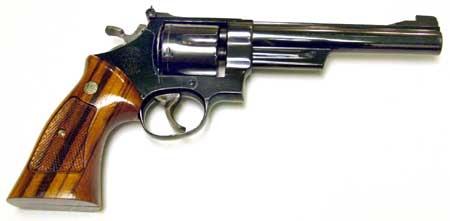 The 1955 Target model Smith & Wesson revolver, .45 ACP caliber, is an accurate, enjoyable shooter with the kind of deep black finish that speaks of the kind of skilled metal finishing only hand work accomplishes. Using recent Rimz brand tough flexible plastic full moon clips, it is easy to load and unload. The beautiful factory grips distribute the rather mild recoil nicely, and make it tempting to consider this as a carry gun for defense in situations where a larger revolver could be used. The only problem with the Rimz clips is that if they are not pressed firmly down, making sure each round is correctly seated in the chamber, it's possible that the cylinder will hang up. The old metal clips, which are somewhat more troublesome to load and unload, are more reliable for quick reloads. The .45 Auto Rimmed cases load without any clips, and may eject more quickly than the set of six empties tied to the clip. A couple of spare metal clips preloaded might be better for a fast reliable reload. For target shooting the plastic clips are easier to load and unload. The 1955 Target model Smith & Wesson revolver, .45 ACP caliber, is an accurate, enjoyable shooter with the kind of deep black finish that speaks of the kind of skilled metal finishing only hand work accomplishes. Using recent Rimz brand tough flexible plastic full moon clips, it is easy to load and unload. The beautiful factory grips distribute the rather mild recoil nicely, and make it tempting to consider this as a carry gun for defense in situations where a larger revolver could be used. The only problem with the Rimz clips is that if they are not pressed firmly down, making sure each round is correctly seated in the chamber, it's possible that the cylinder will hang up. The old metal clips, which are somewhat more troublesome to load and unload, are more reliable for quick reloads. The .45 Auto Rimmed cases load without any clips, and may eject more quickly than the set of six empties tied to the clip. A couple of spare metal clips preloaded might be better for a fast reliable reload. For target shooting the plastic clips are easier to load and unload.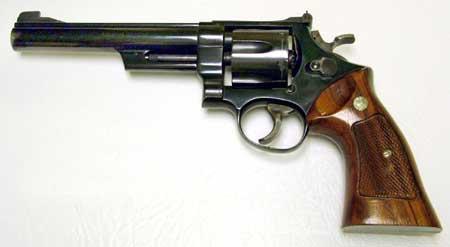 The appeal of this gun is the excellent balance, beautiful finish, smooth operation and almost sensual trigger release in both double and single action...not to mention the sheer fun of firing the .45 ACP with its highly acceptable recoil level and instant visual gratification of the big holes in the target that don't require peeking through the spotting scope. The appeal of this gun is the excellent balance, beautiful finish, smooth operation and almost sensual trigger release in both double and single action...not to mention the sheer fun of firing the .45 ACP with its highly acceptable recoil level and instant visual gratification of the big holes in the target that don't require peeking through the spotting scope. |
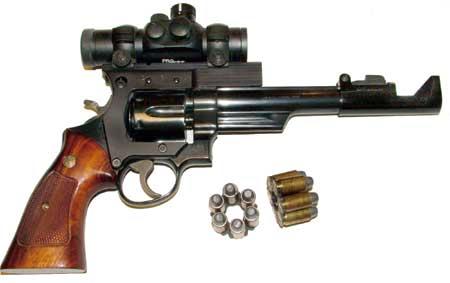 A second S&W 1955 Target model in .45 ACP with Smith & Wesson open muzzle brake and Tasco red-dot which makes it great for indoor target shooting but detracts from the carrying convenience, and the sleek original lines. Still, since it is otherwise exactly like the first, it's fun to shoot them both and compare scores with open sights and optical assistance. A second S&W 1955 Target model in .45 ACP with Smith & Wesson open muzzle brake and Tasco red-dot which makes it great for indoor target shooting but detracts from the carrying convenience, and the sleek original lines. Still, since it is otherwise exactly like the first, it's fun to shoot them both and compare scores with open sights and optical assistance. |
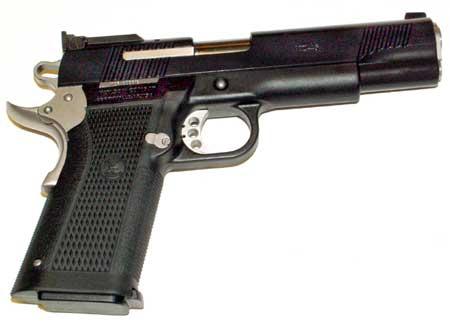 Although the feel of steel and wood trumps plastic for artistic appeal among some old time shooters, there's no denying that modern materials help keep the trousers from sagging, especially with 12 rounds of 230 grain bullets in the magazine and one in the chamber. Although the feel of steel and wood trumps plastic for artistic appeal among some old time shooters, there's no denying that modern materials help keep the trousers from sagging, especially with 12 rounds of 230 grain bullets in the magazine and one in the chamber.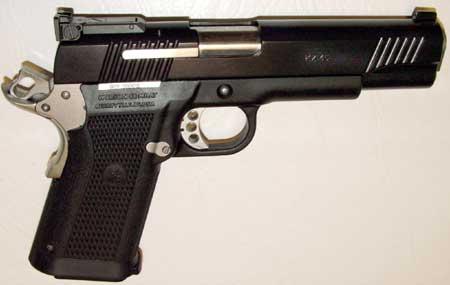 This Wilson Combat Pistol is the 12th one built, with documentation and factory target, but the main reason it is a favorite is the reliable operation combined with easy carry weight. A 1911 isn't that hard to conceal under a business suit. This is a handgun dressed for business. This Wilson Combat Pistol is the 12th one built, with documentation and factory target, but the main reason it is a favorite is the reliable operation combined with easy carry weight. A 1911 isn't that hard to conceal under a business suit. This is a handgun dressed for business.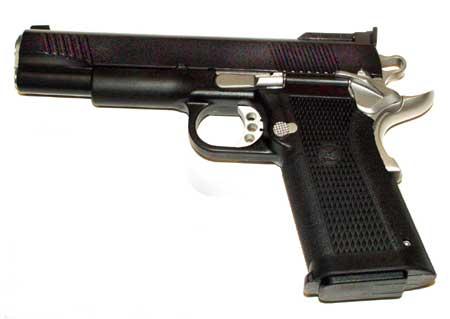 |
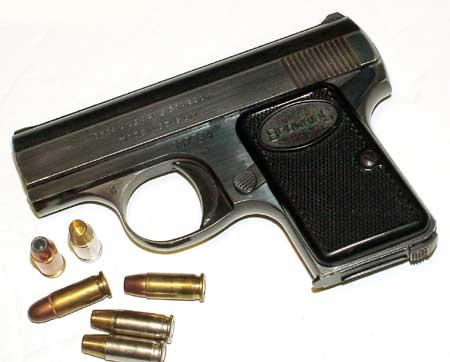 The Baby Browning 25 ACP: a favorite just to own, to hold now and again and admire the engineering, and to think that this little example of John Browning's talent sits at the other extreme of bore sizes from another of his designs, the 1911 .45 ACP. This one was produced in Belgium at Fabrique Nationale, and is a pleasantly well preserved little gem. The Baby Browning 25 ACP: a favorite just to own, to hold now and again and admire the engineering, and to think that this little example of John Browning's talent sits at the other extreme of bore sizes from another of his designs, the 1911 .45 ACP. This one was produced in Belgium at Fabrique Nationale, and is a pleasantly well preserved little gem. |
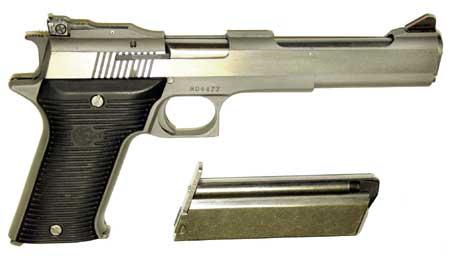 The .22 WMR AMT AutoMag is one of only two autoloading pistols I know about that is chambered for the long, skinny .22 Winchester Magnum Rimfire round, and the only one that can be made to do it reliably. It's an example of fine engineering that sometimes had faulty execution in manufacturing. This one is made right, and works very reliably with Winchester ammunition, not quite 100% with CCI. The chamber has three rows of small dents, which delay the blowback. Oddly enough, this well balanced gun can be carried in a Colt Commander holster. The .22 WMR AMT AutoMag is one of only two autoloading pistols I know about that is chambered for the long, skinny .22 Winchester Magnum Rimfire round, and the only one that can be made to do it reliably. It's an example of fine engineering that sometimes had faulty execution in manufacturing. This one is made right, and works very reliably with Winchester ammunition, not quite 100% with CCI. The chamber has three rows of small dents, which delay the blowback. Oddly enough, this well balanced gun can be carried in a Colt Commander holster.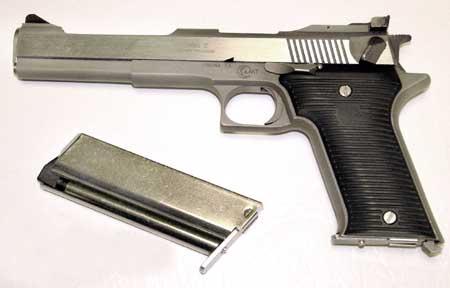 Arcadia Machine Works moved production to Covina, California, and for some time the guns were not necessarily consistent in quality control. But the ones that were are fine examples of gunmaking, and a pleasure to shoot. Arcadia Machine Works moved production to Covina, California, and for some time the guns were not necessarily consistent in quality control. But the ones that were are fine examples of gunmaking, and a pleasure to shoot. |
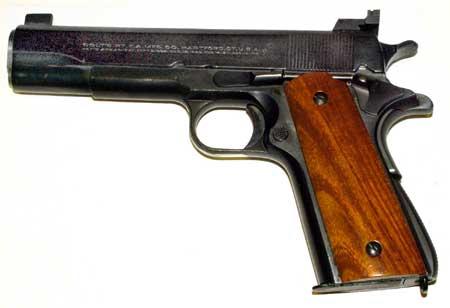 The Model 1927 Argentine Colt 45 ACP is a 1911 version made for Argentina. This is one of those guns you don't know why you keep around, when you have so many "better" ones, but it's also one that works reliably, has been modified with adjustable sights and pleasant smooth wood grips that were made by gun writer Dean Grennell (one-time writer for Gun World, a Handgunner of the Year, and a friend until his death). This gun just happens to have the same serial number on the barrel as on the slide. It's a gun to carry when there's a chance the gun might encounter some rough treatment, since it's not a collector's item. But it's a reasonable shooter. The Model 1927 Argentine Colt 45 ACP is a 1911 version made for Argentina. This is one of those guns you don't know why you keep around, when you have so many "better" ones, but it's also one that works reliably, has been modified with adjustable sights and pleasant smooth wood grips that were made by gun writer Dean Grennell (one-time writer for Gun World, a Handgunner of the Year, and a friend until his death). This gun just happens to have the same serial number on the barrel as on the slide. It's a gun to carry when there's a chance the gun might encounter some rough treatment, since it's not a collector's item. But it's a reasonable shooter.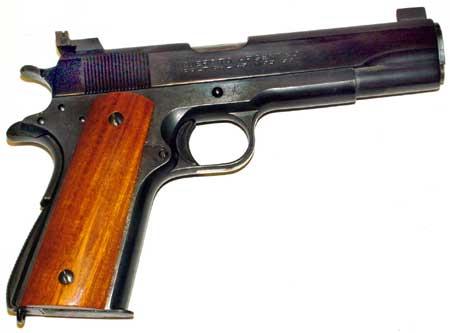 |
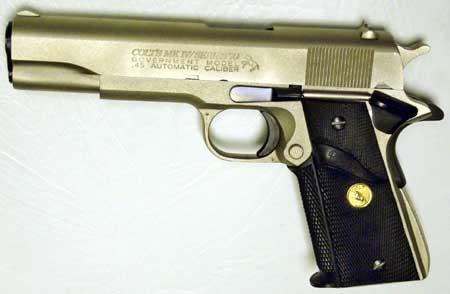 This Series 70 Mark IV Colt 45 ACP is factory original all the way, and a good defense carry gun. It's heavy, solid and reliable. But in particular, it is one of the stepping stones along the long path of 1911 pistol development, with its original box, instruction booklet, magazine, and even the price tag from the year it was sold. The electroless nickel finish isn't the rich blue of the post-war Smith and Wessons, but it is interesting in its own right. This Series 70 Mark IV Colt 45 ACP is factory original all the way, and a good defense carry gun. It's heavy, solid and reliable. But in particular, it is one of the stepping stones along the long path of 1911 pistol development, with its original box, instruction booklet, magazine, and even the price tag from the year it was sold. The electroless nickel finish isn't the rich blue of the post-war Smith and Wessons, but it is interesting in its own right.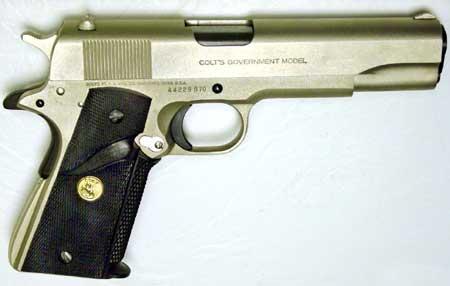 |
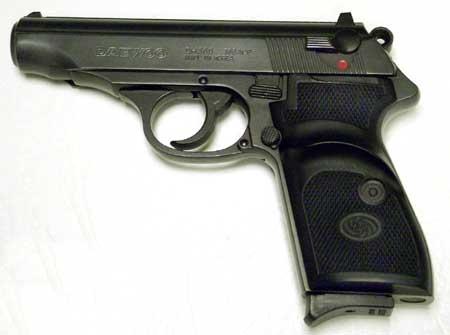 This is a Korean copy of the Walther PPK, but in some ways it is actually a little nicer done than the original. It was short-lived in production, was imported by Kimber, in Clacamas, Oregon, and somehow wound up being a backup carry gun for many years, and in fact, still often is! This is a Korean copy of the Walther PPK, but in some ways it is actually a little nicer done than the original. It was short-lived in production, was imported by Kimber, in Clacamas, Oregon, and somehow wound up being a backup carry gun for many years, and in fact, still often is!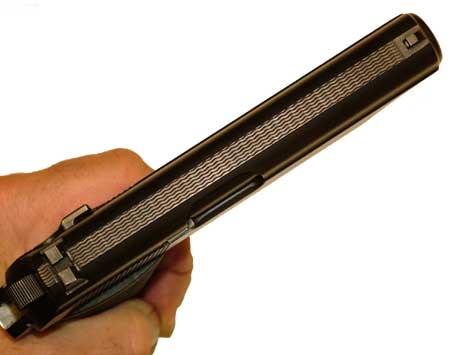 The .380 Caliber is not, of course, first choice for defense. If one is expecting trouble, why not just pick up a 12-gauge pump and forget the handguns? Most of the places I go there's little chance of that kind of trouble, just a remote possibility in a few of them, and most of the time, a better response would be to get out of the situation before it has a chance to develop. Still, even remote chances sometimes occur, or no one would buy lottery tickets. The convenience of the small size coupled with the solid feel of all-steel construction means it is pleasant to shoot, which means practices are fun, and we tend to do what is fun more frequently. Having something you know how to use when you need it beats having something better locked up at home. The .380 Caliber is not, of course, first choice for defense. If one is expecting trouble, why not just pick up a 12-gauge pump and forget the handguns? Most of the places I go there's little chance of that kind of trouble, just a remote possibility in a few of them, and most of the time, a better response would be to get out of the situation before it has a chance to develop. Still, even remote chances sometimes occur, or no one would buy lottery tickets. The convenience of the small size coupled with the solid feel of all-steel construction means it is pleasant to shoot, which means practices are fun, and we tend to do what is fun more frequently. Having something you know how to use when you need it beats having something better locked up at home.There are only a couple of things wrong with this pistol. One is that magazines are almost impossible to find, because it isn't an exact copy of a Walther. The second is that, like the Walther, the safety works backward to my way of thinking. It moves up to fire, down for safe. In a pinch, that might not be great for speed, since we do what we have practiced, and most other pistols thumb the safety down to fire. It takes a fair amount of practice to keep that "hand memory" active, so that the feel of the solid little pistol triggers the right "ready for firing" movements without having to think about it. |
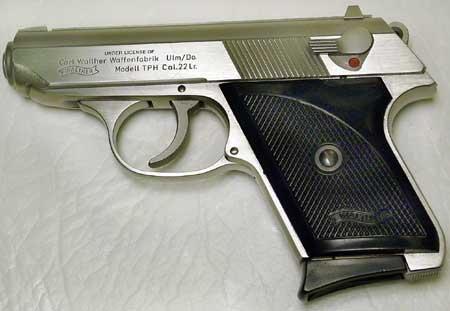 This one got away! I recently traded it for one of the Ford Gun Shop's hard chromed 1903 Colts (7.65mm Browning caliber). Don't think I'll regret it, since I've hardly seen a 1903 or 1908 Colt (or a 1910 or 1955 Browning) that didn't want to leap into my pocket all by itself. The Walther PTH 22LR was yet another gun with the "backward" safety, but at least magazines are still available! It's in the favorites collection mostly because of the engineering and the quality of manufacturing, but also because it's easy to slip into a suit pocket and not make an unsightly bulge. A 22LR is better than a rock, and any gun has more intimidation value than a defiant glare, especially in combination with it. Still, the only living creature this pocket pistol has ever shot at was a woodpecker. Even then, the critter was chased off by a purposeful near miss with a load of number 12 shot and the loud noise. My wife wanted me to shoot the bird, because it was damaging one of the trees near the house, but I figured I'd give it one chance to take its hole-drilling elsewhere, and aimed just below. It took the hint. I still like to take this gun out and see how closely I can make six holes in a 50-foot rapid fire target, every now and again (not all that close...maybe the woodpecker was lucky I didn't accidently drill him!). This one got away! I recently traded it for one of the Ford Gun Shop's hard chromed 1903 Colts (7.65mm Browning caliber). Don't think I'll regret it, since I've hardly seen a 1903 or 1908 Colt (or a 1910 or 1955 Browning) that didn't want to leap into my pocket all by itself. The Walther PTH 22LR was yet another gun with the "backward" safety, but at least magazines are still available! It's in the favorites collection mostly because of the engineering and the quality of manufacturing, but also because it's easy to slip into a suit pocket and not make an unsightly bulge. A 22LR is better than a rock, and any gun has more intimidation value than a defiant glare, especially in combination with it. Still, the only living creature this pocket pistol has ever shot at was a woodpecker. Even then, the critter was chased off by a purposeful near miss with a load of number 12 shot and the loud noise. My wife wanted me to shoot the bird, because it was damaging one of the trees near the house, but I figured I'd give it one chance to take its hole-drilling elsewhere, and aimed just below. It took the hint. I still like to take this gun out and see how closely I can make six holes in a 50-foot rapid fire target, every now and again (not all that close...maybe the woodpecker was lucky I didn't accidently drill him!).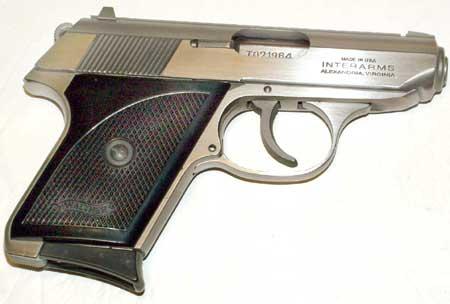 |
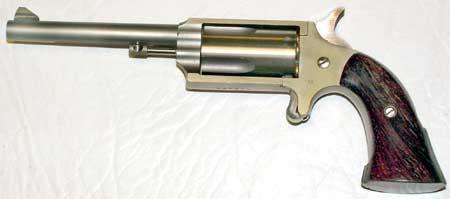 I've worn "cowboy" boots for most of my adult life, when I'm not wearing running shoes or tassle loafers or moccasins, and this little backup gun has been in quite a few of them. There's a clip-on leather holster that grips the high tops firmly and wraps around the grip so it can still be withdrawn, but won't fall out if I'm running...which, if possible and successful, would be vastly better than trusting to superior marksmanship. But if there is no other option, there's some comfort in the little extra weight in one boot. I've worn "cowboy" boots for most of my adult life, when I'm not wearing running shoes or tassle loafers or moccasins, and this little backup gun has been in quite a few of them. There's a clip-on leather holster that grips the high tops firmly and wraps around the grip so it can still be withdrawn, but won't fall out if I'm running...which, if possible and successful, would be vastly better than trusting to superior marksmanship. But if there is no other option, there's some comfort in the little extra weight in one boot.The worksmanship on these discontinued FA 22 WMR boot pistols is remarkable. While I'm a fan of the larger revolvers, you can't always have that much mass handy, and at reasonable close ranges it's not hard to put the .22 Mag bullet almost exactly where you want it, four times, fast. Many's the evening when a stroll along the darkened backways from an evening performance at the Ginger Rogers Theater to the downtown Medford parking garage was made just a touch less risky with the unobtrusive presence of this handy 4-shooter backing up a .380 under the coat. It also has a .22LR cylinder, which doesn't see much use. 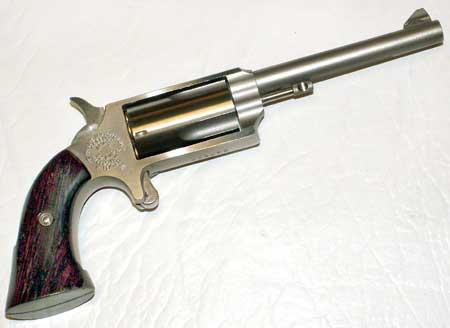 |
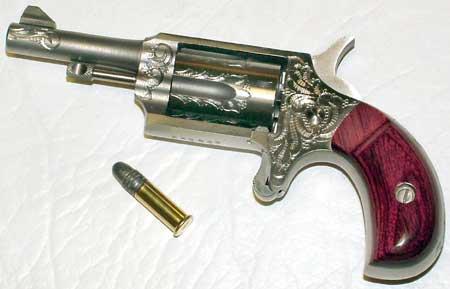 This little jewel of the discontinued Freedom Arms (Dick Casull Patent) 22 pocket pistol is one of two nearly identical that I have kept over the years, and carried around with me in various jacket pockets, ankle holsters, and sewn-in coat lining pouches when I traveled to less comfortable parts of the world, before metal detectors became quite so often encountered. It's been a bit of engineering art I could admire together with the worksmanship of its construction, and then slip it back into quiet duty as a backup or when nothing larger would be appropriate. This little jewel of the discontinued Freedom Arms (Dick Casull Patent) 22 pocket pistol is one of two nearly identical that I have kept over the years, and carried around with me in various jacket pockets, ankle holsters, and sewn-in coat lining pouches when I traveled to less comfortable parts of the world, before metal detectors became quite so often encountered. It's been a bit of engineering art I could admire together with the worksmanship of its construction, and then slip it back into quiet duty as a backup or when nothing larger would be appropriate.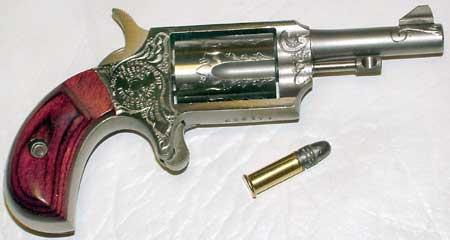 To load, you turn the rod 90 degrees and pull it out, which drops out the cylinder. Then you push out the four empty cases, push in four new ones, and slip the cylinder back into the frame, push the rod home and turn it 90 degrees to latch into place. People often ask "Can you hit anything with that thing?" Sure, it's not as hard as you might think. Just takes a little practice. It's a single-action only, with a moderately smooth light trigger, and you just sight down the notch on the frame top to align the respectable front sight. Then practice a lot to figure out where a particular brand and type of ammo will print, and hold to compensate as necessary. If you can repeat the same hold, it shoots to the same place. To load, you turn the rod 90 degrees and pull it out, which drops out the cylinder. Then you push out the four empty cases, push in four new ones, and slip the cylinder back into the frame, push the rod home and turn it 90 degrees to latch into place. People often ask "Can you hit anything with that thing?" Sure, it's not as hard as you might think. Just takes a little practice. It's a single-action only, with a moderately smooth light trigger, and you just sight down the notch on the frame top to align the respectable front sight. Then practice a lot to figure out where a particular brand and type of ammo will print, and hold to compensate as necessary. If you can repeat the same hold, it shoots to the same place. |
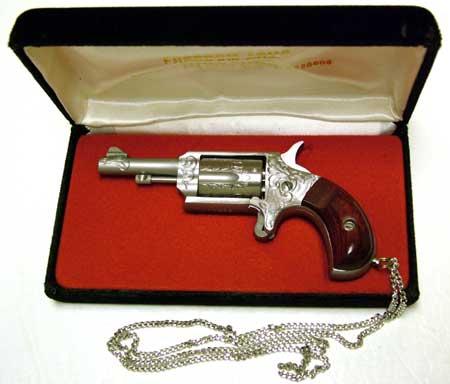 This Freedom Arms 22 LR engraved pocket pistol, with attached neck chain, was a gift to my wife. It is a piece of jewelry that offers its own defense. In truth, it's a novelty for the art and the idea, more than a practical carry piece. Even though it's stainless steel, hanging between the breasts isn't probably the best climate to preserve it, to say nothing of the reverse engraved scrollwork that would be pressed into the skin after an evening's wear. No, it's one of those guns kept around because it's pretty, not because it gets used. The chain is solid, without a clasp, so it slips over the head. There's a nice box from Freedom Arms, also. This Freedom Arms 22 LR engraved pocket pistol, with attached neck chain, was a gift to my wife. It is a piece of jewelry that offers its own defense. In truth, it's a novelty for the art and the idea, more than a practical carry piece. Even though it's stainless steel, hanging between the breasts isn't probably the best climate to preserve it, to say nothing of the reverse engraved scrollwork that would be pressed into the skin after an evening's wear. No, it's one of those guns kept around because it's pretty, not because it gets used. The chain is solid, without a clasp, so it slips over the head. There's a nice box from Freedom Arms, also.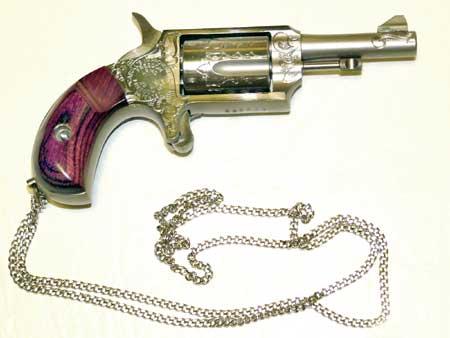 |
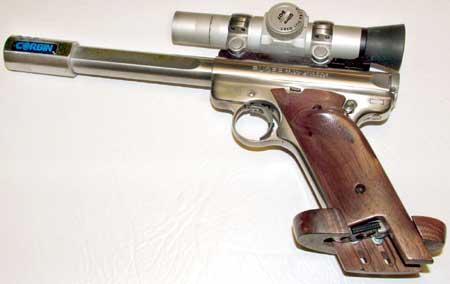 Now this gun gets used! It is shot almost every Monday night at the Medford Rifle and Pistol Club Bullseye practices, 900 point simulated matches with taped range commands. My wife purchased the Ruger Mark II Competition Target Pistol (22LR) as a Christmas present and I've had fun "fixing it up" with accessories to make me think I can suddenly shoot better. It always works, because if I think something will help, it helps...at least one time. Then I realize I'm making the same progress as usual, or treading water, depending on the effort put into concentration on the basics of trigger control. The red dot helps eliminate some of the variables of sight picture, but mostly it makes old eyes think they can see better. Funny thing...sometimes when I don't think too much about it, I can shoot the same groups with iron sights just by using a little Merit apperture stuck on my glasses to sharpen the front sight. What did Yogi Berra say, something like "half this game is 90% mental?". Now this gun gets used! It is shot almost every Monday night at the Medford Rifle and Pistol Club Bullseye practices, 900 point simulated matches with taped range commands. My wife purchased the Ruger Mark II Competition Target Pistol (22LR) as a Christmas present and I've had fun "fixing it up" with accessories to make me think I can suddenly shoot better. It always works, because if I think something will help, it helps...at least one time. Then I realize I'm making the same progress as usual, or treading water, depending on the effort put into concentration on the basics of trigger control. The red dot helps eliminate some of the variables of sight picture, but mostly it makes old eyes think they can see better. Funny thing...sometimes when I don't think too much about it, I can shoot the same groups with iron sights just by using a little Merit apperture stuck on my glasses to sharpen the front sight. What did Yogi Berra say, something like "half this game is 90% mental?".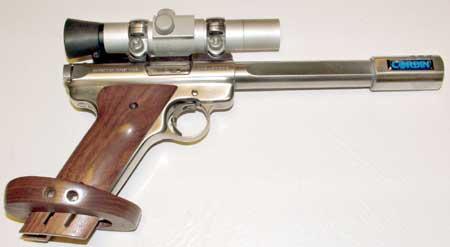 |
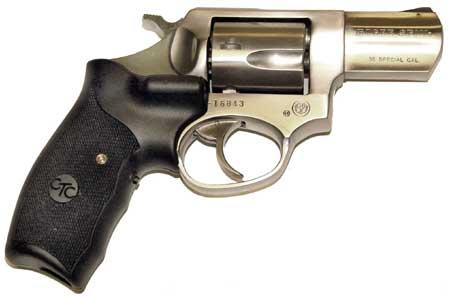 Here's another gun that gets shot a lot, carried a lot more, and fortunately never "used" for its main purpose, self-defense. It's the one I generally wear when I'm doing a little volunteer armed guard duty overnight at a club gun show, because it is comfortable, familiar, reliable, and with the Crimson Trace laser grips, it has both a high intimidation factor (so maybe it won't have to be fired, best possible scenario if it has to be pulled at all) and a pretty good probability of hitting the target in the dark. Here's another gun that gets shot a lot, carried a lot more, and fortunately never "used" for its main purpose, self-defense. It's the one I generally wear when I'm doing a little volunteer armed guard duty overnight at a club gun show, because it is comfortable, familiar, reliable, and with the Crimson Trace laser grips, it has both a high intimidation factor (so maybe it won't have to be fired, best possible scenario if it has to be pulled at all) and a pretty good probability of hitting the target in the dark.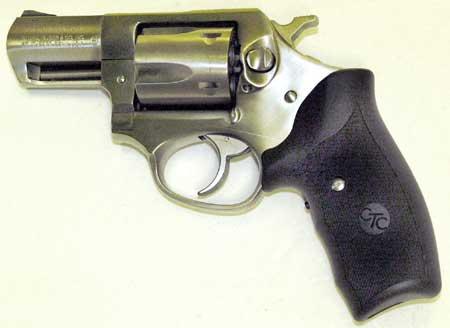 If I'm in a situation where the gun would benefit from a longer barrel, it can also stand to be a little larger in other respects, so then the choice would be something heavier to carry, like a .45, or sometimes a .357 Magnum. This stubby handgun rides nicely in a Safariland leather belt holster, and is just the right amount of presence, not too bulky, for walk around security where the odds of needing it are pretty much nil, except insurance requires it...and if you didn't have it, someone might be tempted to do evil who otherwise never would take the chance. If I'm in a situation where the gun would benefit from a longer barrel, it can also stand to be a little larger in other respects, so then the choice would be something heavier to carry, like a .45, or sometimes a .357 Magnum. This stubby handgun rides nicely in a Safariland leather belt holster, and is just the right amount of presence, not too bulky, for walk around security where the odds of needing it are pretty much nil, except insurance requires it...and if you didn't have it, someone might be tempted to do evil who otherwise never would take the chance.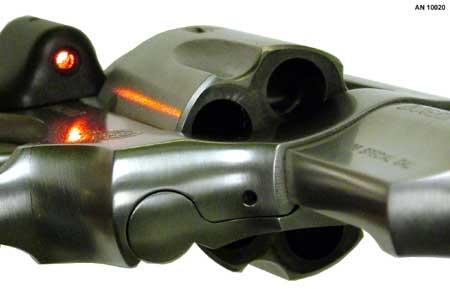 |
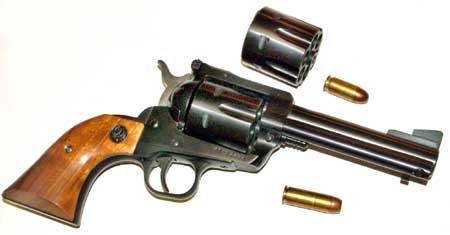 While we're looking at Rugers, here's one of many single actions I've owned over the years. This Ruger Black Hawk 45 Long Colt has the original yellow and black box, and the convertible cylinder for .45 ACP. Having owned and shot a large number of single action Rugers, including the Bearcat 22, .41 Magnum, and even the single shot .256 Winchester Hawkeye, I thought it would be nice to have one that could fire my favorite pistol cartrige (.45 ACP) without a half-moon or full moon clip. Since it ejects by pushing on the ejector rod, there's no need for a rim or an extractor device. While we're looking at Rugers, here's one of many single actions I've owned over the years. This Ruger Black Hawk 45 Long Colt has the original yellow and black box, and the convertible cylinder for .45 ACP. Having owned and shot a large number of single action Rugers, including the Bearcat 22, .41 Magnum, and even the single shot .256 Winchester Hawkeye, I thought it would be nice to have one that could fire my favorite pistol cartrige (.45 ACP) without a half-moon or full moon clip. Since it ejects by pushing on the ejector rod, there's no need for a rim or an extractor device.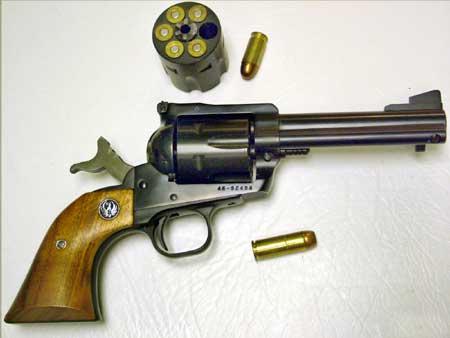 |
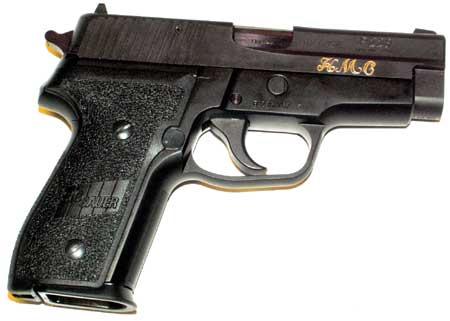 This one is my wife's 9mm Sig-Saur P228, with her initials inlaid in gold on the slide. It was a present, a result of reading a number of mystery and spy novels in which the gun was more or less accurately described with considerable praise, most of which appears to have been deserved. This one is my wife's 9mm Sig-Saur P228, with her initials inlaid in gold on the slide. It was a present, a result of reading a number of mystery and spy novels in which the gun was more or less accurately described with considerable praise, most of which appears to have been deserved.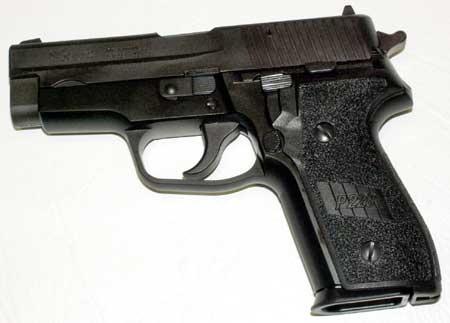 |
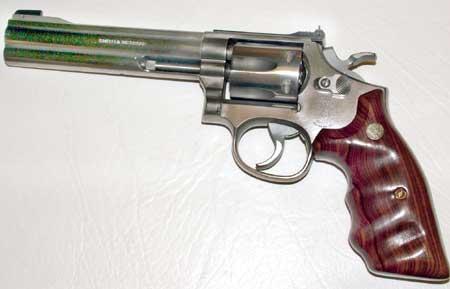 This stainless steel S&W M617 is an earlier 6-shot version without the scope mounting holes (there are 10 chamber cylinder versions with the top drilled and tapped for scope mounts now). It's a stepping stone on the K-frame trail, similar to the earlier K-22 Masterpiece target revolver. The reason I got it was because some of the .22 ammo I was buying in fairly large quantities was out of spec, being slightly too large (.225-.226 OD) to reliably chamber in the close tolerance Ruger competition target model. The same ammo fit and fired just fine in the revolver, and didn't have any accuracy issues that were apparent at my normal level of shooting. This stainless steel S&W M617 is an earlier 6-shot version without the scope mounting holes (there are 10 chamber cylinder versions with the top drilled and tapped for scope mounts now). It's a stepping stone on the K-frame trail, similar to the earlier K-22 Masterpiece target revolver. The reason I got it was because some of the .22 ammo I was buying in fairly large quantities was out of spec, being slightly too large (.225-.226 OD) to reliably chamber in the close tolerance Ruger competition target model. The same ammo fit and fired just fine in the revolver, and didn't have any accuracy issues that were apparent at my normal level of shooting.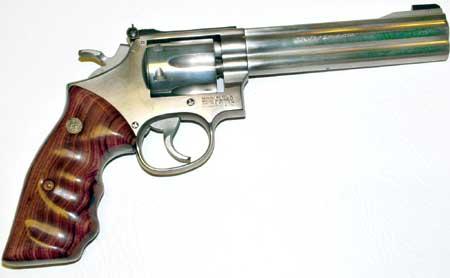 Although a red-dot sight provides a high level of psychological confidence, when I use a Merit apperture on my glasses, and concentrate on trigger control instead of lamenting my less than youthful vision, I often shoot just as well with the open sighted revolver. The power of the mind is such that even knowing it's all in one's head doesn't seem to get it out! It's good to have a 22 target revolver with iron sights, just to work on the issue, which translates to even better scores when using all the whistles and bells on a target auto. And to use up the ammo that won't work in a tight chambered pistol. Although a red-dot sight provides a high level of psychological confidence, when I use a Merit apperture on my glasses, and concentrate on trigger control instead of lamenting my less than youthful vision, I often shoot just as well with the open sighted revolver. The power of the mind is such that even knowing it's all in one's head doesn't seem to get it out! It's good to have a 22 target revolver with iron sights, just to work on the issue, which translates to even better scores when using all the whistles and bells on a target auto. And to use up the ammo that won't work in a tight chambered pistol. |
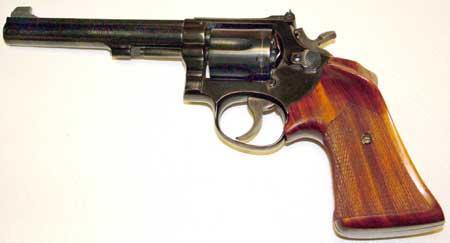 Original Smith and Wesson K-38 purchased from a Wichita, Kansas, gun dealer when I was still in high school (back in the day when a teenager who practiced a lot with target guns wasn't considered anything but a good shooter). The grips came from Herter's. This gun has been with me for decades, and is in excellent condition since I shot mostly .45 and .22 over the years, with relatively few 3-gun competitions between my Navy pistol shooting days with the .45 exclusively and the mostly 22 caliber local gun club matches thereafter. It has the beautiful deep blue found on the model 25's, the smooth double action pull and the crisp single action release that today are added-value services of custom gunsmiths. Accurate? You bet. For sale? Not likely. Original Smith and Wesson K-38 purchased from a Wichita, Kansas, gun dealer when I was still in high school (back in the day when a teenager who practiced a lot with target guns wasn't considered anything but a good shooter). The grips came from Herter's. This gun has been with me for decades, and is in excellent condition since I shot mostly .45 and .22 over the years, with relatively few 3-gun competitions between my Navy pistol shooting days with the .45 exclusively and the mostly 22 caliber local gun club matches thereafter. It has the beautiful deep blue found on the model 25's, the smooth double action pull and the crisp single action release that today are added-value services of custom gunsmiths. Accurate? You bet. For sale? Not likely.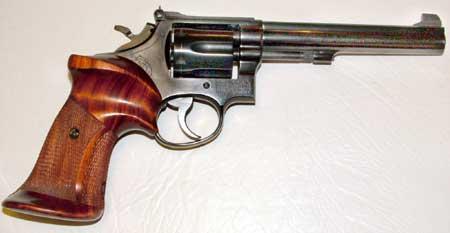 |
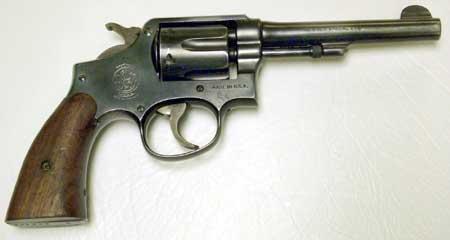 This "S" prefix serial numbered hand ejector has the same plain wood grips used on wartime "Victory" models, but too high a serial number, too nice a finish, and no "V" to indicate the wartime production, nor any U.S. property stamps anywhere. The cylinder and grip frame serials match, and the old pre-Model 10 still operates with pleasant smoothness. It's an obvious postwar production, not necessarily a "collector", but not too many fellow shooters would scoff at the idea of occasionally admiring and even shooting an example of one of the most popular revolvers Smith and Wesson ever made. This "S" prefix serial numbered hand ejector has the same plain wood grips used on wartime "Victory" models, but too high a serial number, too nice a finish, and no "V" to indicate the wartime production, nor any U.S. property stamps anywhere. The cylinder and grip frame serials match, and the old pre-Model 10 still operates with pleasant smoothness. It's an obvious postwar production, not necessarily a "collector", but not too many fellow shooters would scoff at the idea of occasionally admiring and even shooting an example of one of the most popular revolvers Smith and Wesson ever made.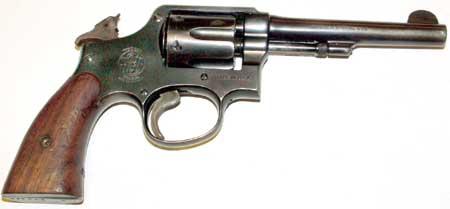 |
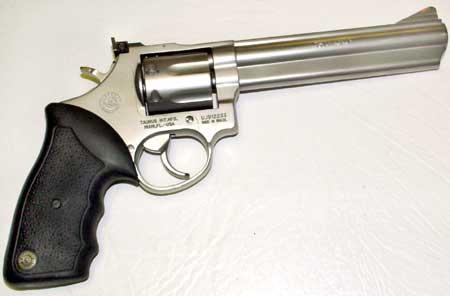 Taurus made some rather nice revolvers in Brazil on the pattern of Smith & Wesson models, and this stainless steel .357 Magnum compares well. It was purchased primarily to see whether Taurus and current production Smiths offered comparable performance, accuracy, reliability, and worksmanship. If this revolver is representative, then I'd have to say yes. Taurus doesn't have the cachet and history that makes the Smith's so desirable, and a competent gunsmith might offer convincing reasons to prefer the Smith. But at least this Taurus has made a new friend. Taurus made some rather nice revolvers in Brazil on the pattern of Smith & Wesson models, and this stainless steel .357 Magnum compares well. It was purchased primarily to see whether Taurus and current production Smiths offered comparable performance, accuracy, reliability, and worksmanship. If this revolver is representative, then I'd have to say yes. Taurus doesn't have the cachet and history that makes the Smith's so desirable, and a competent gunsmith might offer convincing reasons to prefer the Smith. But at least this Taurus has made a new friend.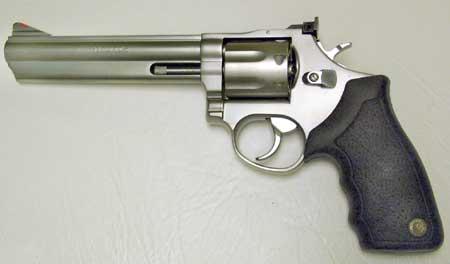 This gun lets me fire those hotter loads that I might not completely trust in my earlier Smiths, or that might be a little unpleasant in the short barrel Ruger. And of course anyone with a broad interest in handguns needs a tool for launching 357 Magnums now and again. This gun lets me fire those hotter loads that I might not completely trust in my earlier Smiths, or that might be a little unpleasant in the short barrel Ruger. And of course anyone with a broad interest in handguns needs a tool for launching 357 Magnums now and again.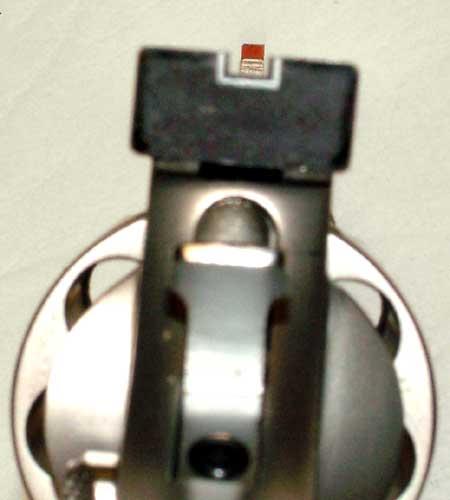 The Taurus sight picture: a little to the left, a little lower, please! Ahh, right there! Hold and squeeze... There's a bullseye. The Taurus sight picture: a little to the left, a little lower, please! Ahh, right there! Hold and squeeze... There's a bullseye. |
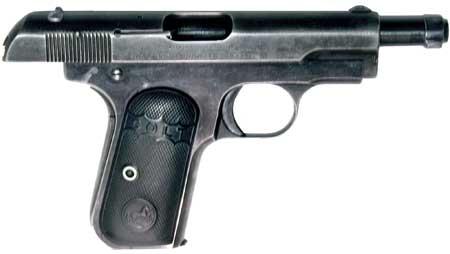 Ok, I'm going to catch some grief for this one, but I don't mind. This century-old Browning patent Colt 1903 pocket pistol quietly slips into the hand and instantly makes you aware of its intuitive grace and elegant design. Although it has seen some rough times, you can still see traces of the peacock blue "fire-blueing" on the trigger and slide catch, and get a hint of what was once a rich dark blue-black finish everywhere else. But more importantly, it still works flawlessly, even with its 100 year old springs and turn of the century metalurgy. Ok, I'm going to catch some grief for this one, but I don't mind. This century-old Browning patent Colt 1903 pocket pistol quietly slips into the hand and instantly makes you aware of its intuitive grace and elegant design. Although it has seen some rough times, you can still see traces of the peacock blue "fire-blueing" on the trigger and slide catch, and get a hint of what was once a rich dark blue-black finish everywhere else. But more importantly, it still works flawlessly, even with its 100 year old springs and turn of the century metalurgy.I saw this in a local gun shop and was instantly attracted but couldn't really justify buying another old gun. I researched it to death, instead. Kept going into the gun shop and looking at it, checking out the details, looking up serial number history and fine points of its design, and then one day it was gone. Someone bought it? Yep. Those guys knew it was my wife, but they never cracked a smile! She gave it to me for my birthday about a month later! 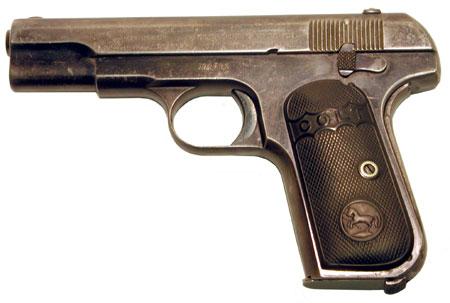 The so-called "M" series Colts don't have polymer frames, but they do have simple intuitive safety devices that work. They slip flat into your pocket with nothing sharp to catch, and put their projectiles in the 10 ring at close range time after time, once you master the sights and develop a consistent grip. About the only thing wrong with this little pistol is the comparatively low power of the "32 Rimless Smokeless" round, which was upgraded to .380 ACP with the 1908 version. Regardless, it's a joy to shoot, and almost as pleasant just to examine, while wishing a modern replica was available to customize! (How about it, Taurus?) The so-called "M" series Colts don't have polymer frames, but they do have simple intuitive safety devices that work. They slip flat into your pocket with nothing sharp to catch, and put their projectiles in the 10 ring at close range time after time, once you master the sights and develop a consistent grip. About the only thing wrong with this little pistol is the comparatively low power of the "32 Rimless Smokeless" round, which was upgraded to .380 ACP with the 1908 version. Regardless, it's a joy to shoot, and almost as pleasant just to examine, while wishing a modern replica was available to customize! (How about it, Taurus?) |
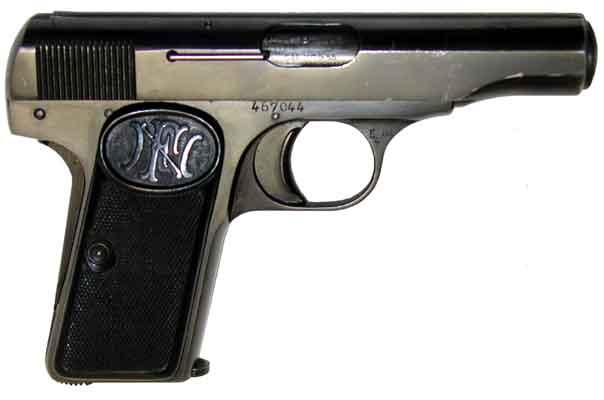 One of my all time favorites, along with the 1903 or 1908 Colt design, is this 1910 Browning (in 7.65mm or 9mm Browning Short (.380 ACP). Forget about the caliber for a moment and just look at the lines and ergonomics of this 97 year old design. It's as pleasant to shoot as any gun I've owned. With the recoil spring around the barrel, you can remove the barrel, spring, and slide just by pulling the slide back, turning the barrel so the lugs move out of the frame and into a recess in the slide (which captures the spring between the larger chamber section on the barrel and the removable bushing on the front of the slide). Then just slip the frame, with barrel and spring, off the frame. One of my all time favorites, along with the 1903 or 1908 Colt design, is this 1910 Browning (in 7.65mm or 9mm Browning Short (.380 ACP). Forget about the caliber for a moment and just look at the lines and ergonomics of this 97 year old design. It's as pleasant to shoot as any gun I've owned. With the recoil spring around the barrel, you can remove the barrel, spring, and slide just by pulling the slide back, turning the barrel so the lugs move out of the frame and into a recess in the slide (which captures the spring between the larger chamber section on the barrel and the removable bushing on the front of the slide). Then just slip the frame, with barrel and spring, off the frame.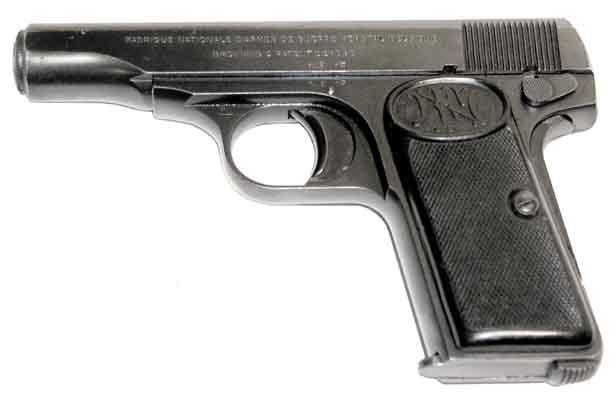 Even more than the Colt 1903, the 1910 Browning (which was modified to make the Model 1922 by adding a longer barrel, a barrel extension instead of the little knurled bushing, and a longer grip and magazine that holds another round) is a streamlined pocket pistol with nothing to hang up on your clothes. It has vestigal sights, but a very natural feel for point and shoot capability. The Browning grip safety (also on the 1903 Colt), plus the slide-locking thumb safety, work with good efficiency. Unlike the Walther PPK, the safety pushes down to fire and seems more "natural" to operate. Even more than the Colt 1903, the 1910 Browning (which was modified to make the Model 1922 by adding a longer barrel, a barrel extension instead of the little knurled bushing, and a longer grip and magazine that holds another round) is a streamlined pocket pistol with nothing to hang up on your clothes. It has vestigal sights, but a very natural feel for point and shoot capability. The Browning grip safety (also on the 1903 Colt), plus the slide-locking thumb safety, work with good efficiency. Unlike the Walther PPK, the safety pushes down to fire and seems more "natural" to operate.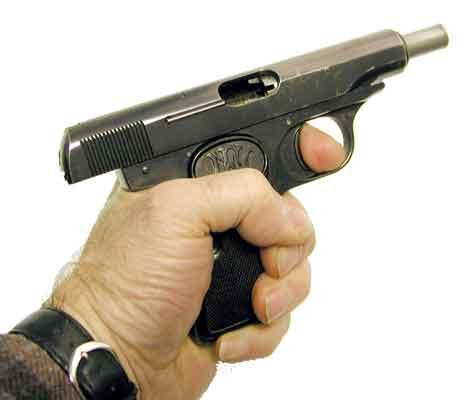 Excuse me for giving this model more pictures...it's been an all-time favorite handgun for 40 years. This gun was imported to the USA as the Model 1955, right up till the 1968 Gun Control Act stopped the imports. With the 1910 or 1955 models, you can have a solid all-steel gun that fits any pocket and won't warp, crack, or melt, and digests handloads all day long. You can get tough polymer epoxy grips in any color from Tombstone Gun Grips, PO Box 2171, White City, OR 97503. Excellent holsters for 1910 Brownings and 1903 Colts are available from A.E. Nelson Leather Company, in Scio, Oregon. Excuse me for giving this model more pictures...it's been an all-time favorite handgun for 40 years. This gun was imported to the USA as the Model 1955, right up till the 1968 Gun Control Act stopped the imports. With the 1910 or 1955 models, you can have a solid all-steel gun that fits any pocket and won't warp, crack, or melt, and digests handloads all day long. You can get tough polymer epoxy grips in any color from Tombstone Gun Grips, PO Box 2171, White City, OR 97503. Excellent holsters for 1910 Brownings and 1903 Colts are available from A.E. Nelson Leather Company, in Scio, Oregon. |
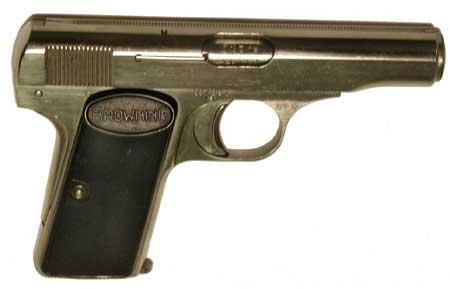 The 1955 Browning is the same 1910 model marketed especiall for US sales. This one is a factory nickel plated version in .380 ACP (marked 9mm on the barrel, but means 9mm short or Browning). The grips say "Browning" instead of "FN", and the slide is marked with "Made in Belgium" but also with "Browning Arms" in Toronto and St.Louis. But other than cosmetics, 45 years of production still gave the world an elegant, easy to carry defense pistol with the signature Browning grip safety. The 1955 Browning is the same 1910 model marketed especiall for US sales. This one is a factory nickel plated version in .380 ACP (marked 9mm on the barrel, but means 9mm short or Browning). The grips say "Browning" instead of "FN", and the slide is marked with "Made in Belgium" but also with "Browning Arms" in Toronto and St.Louis. But other than cosmetics, 45 years of production still gave the world an elegant, easy to carry defense pistol with the signature Browning grip safety.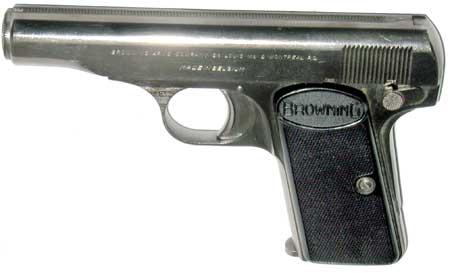 Nickel finished factory original is almost the last of the old 1910 "New Model" line. The Gun Control Act of 1968 doomed the pistol, which fell into the size and importation restrictions. In 1975, a last ditch effort was made to get around the restrictions by adding target sights and an extended magazine finger rest. But this gun was never intended as a target pistol, and the additions went against the original size and shape of a pocket pistol. After a short run, the model was discontinued. Even the double-action DBA .380 Browning (not the same gun at all) wasn't able to recapture the elegant lines and easy feel of this excellent 1910 design. Nickel finished factory original is almost the last of the old 1910 "New Model" line. The Gun Control Act of 1968 doomed the pistol, which fell into the size and importation restrictions. In 1975, a last ditch effort was made to get around the restrictions by adding target sights and an extended magazine finger rest. But this gun was never intended as a target pistol, and the additions went against the original size and shape of a pocket pistol. After a short run, the model was discontinued. Even the double-action DBA .380 Browning (not the same gun at all) wasn't able to recapture the elegant lines and easy feel of this excellent 1910 design.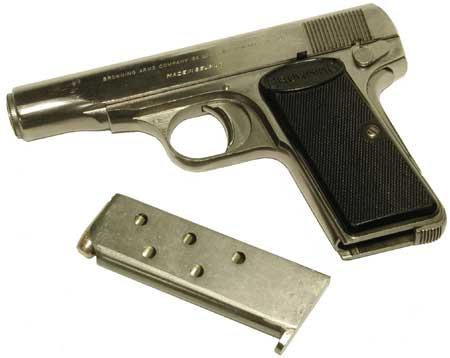 The little Browning slips easily into a jacket pocket, and digests most .380 ACP rounds without fail. Some of the flat tipped Winchester rounds don't seem to feed quite as well when operating the slide by hand, but cycle OK when fired. Custom aged ivory or white polymer grips are available for these pistols from The little Browning slips easily into a jacket pocket, and digests most .380 ACP rounds without fail. Some of the flat tipped Winchester rounds don't seem to feed quite as well when operating the slide by hand, but cycle OK when fired. Custom aged ivory or white polymer grips are available for these pistols fromTombstone Gun Grips PO Box 2171 White City, OR 97503 You can dress up yours with grips that are sturdy and attractive, and save your originals from becoming damaged or worn if you carry your pistol, preserving a little more of the gun's value if you should wish to sell or trade it later. 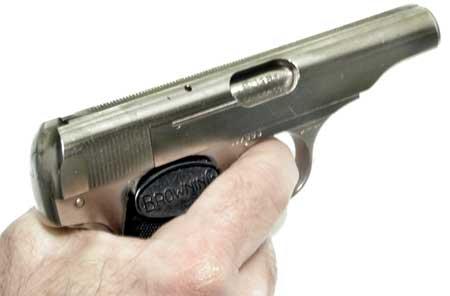 |
Start writing here...
Dave Corbin Favorite Handguns